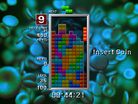Tetris The Grand Master
| Tetris The Grand Master | |
|---|---|
| Developer(s) | Arika |
| Publisher(s) | Capcom |
| Platform(s) | Arcade |
| Release | 1998 Aug |
| Gameplay info | |
| Next pieces | 1 |
| Playfield size | 10x20 |
| Hold piece | No |
| Hard drop | No |
| Rotation system | TGM rotation |
Tetris The Grand Master is the first arcade game in Arika's TGM series.
Gameplay
Unlike typical tetris games where the goal is indefinite survival and a high score, TGM is a challenge where you have a finite opportunity to attain a high Grade. With the exception of the final grade of Grand Master, grade is derived from your score. This indirectly makes the grading system strongly favour survival, with a special emphasis on clearing non-singles late in the game during 20g.
With only a small number of grades, there are often ties. The highscore table ranks a tied grade higher if it was attained faster. In practice, solid play will award players the highest rank of Grand Master. As such, for adequately skilled players the game becomes a time attack to level 999.
Level
Level has a unique implementation in TGM. The level counter will increase by 1 for every piece that enters the well. It will also increase by 1 for each line cleared. The game ends once level 999 is reached.
When you are about to increment the hundreds digit (eg. at level 399), only line clears will count towards your level. Level 998 is treated similarly, with a final line clear required to reach 999 and finish.
Speed Timings
Gravity does not increase uniformly, unlike many other tetris games. It rises and falls, depending on the level as shown in the table below. The player can force constant 20G, by entering a code before starting the game, though this will exclude their play from the highscore list.
The unit for gravity is G (rows per frame), as a fraction with a constant denominator of 256. This means G = Internal Gravity/256. For example, at levels 90 through 99, the gravity is 64/256G, or 1/4G.
| Level | Interal Gravity (1/256 G) |
Level | Internal Gravity (1/256 G) |
|---|---|---|---|
| 0 | 4 | 220 | 32 |
| 30 | 6 | 230 | 64 |
| 35 | 8 | 233 | 96 |
| 40 | 10 | 236 | 128 |
| 50 | 12 | 239 | 160 |
| 60 | 16 | 243 | 192 |
| 70 | 32 | 247 | 224 |
| 80 | 48 | 251 | 256 (1G) |
| 90 | 64 | 300 | 512 (2G) |
| 100 | 80 | 330 | 768 (3G) |
| 120 | 96 | 360 | 1024 (4G) |
| 140 | 112 | 400 | 1280 (5G) |
| 160 | 128 | 420 | 1024 (4G) |
| 170 | 144 | 450 | 768 (3G) |
| 200 | 4 | 500 | 5120 (20G) |
Unlike TGM2, the line clear delay, lock delay, ARE and DAS do not change throughout the game.
| Level | ARE (frames) |
DAS (frames) |
Lock (frames) |
Line clear (frames) |
|---|---|---|---|---|
| 000 - 999 | 25 | 16 | 30 | 40 |
- DAS is inclusive of both the initial shift and the autoshift frames.
- The player's DAS charge is unmodified during line clear delay, three frames of "lock flash" that occur after lock delay expires, and one frame of level-increment delay right before the next piece spawns.
Scoring
TGM shares the same scoring gimmicks of many other Tetris games, though they are not quite implemented the same way:
- You receive more points for clearing more lines at once.
- Lines are worth more with each passing level. (The nature of "level" in TGM, however, means the amount of points a line is worth is constantly changing, and especially in the 0-99 section, it is to the player's advantage to stack high before clearing lines.)
- You receive points for forcing a piece down. (Though only when this results in cleared lines, unlike in several other games.)
There are a few scoring gimmicks unique to TGM:
- You receive a combo bonus for clearing lines with consecutive pieces.
- You receive a bravo bonus for clearing the entire screen.
Incidentally, for all players good enough to attain the rank of S9 score becomes irrelevant and the focus changes to a time attack rather than a score attack. Nevertheless, here is a more technical description of the scoring formula:
Score = ((Level + Lines)/4 + Soft) x Lines x Combo x Bravo
Where:
- Level is the current level you are on.
- Lines is the number of lines you just cleared.
- (Level + Lines)/4 is rounded up.
- Soft is the cummulative number frames during which Down was held during the piece's active time. Note that this means manually locking pieces already on the ground will increase the Soft value by 1.
- Locking a piece without clearing lines sets Combo to 1. Otherwise, the game updates Combo as follows before calculating Score:
- Combo = (previous Combo value) + (2 x Lines) - 2
- Example: A double-triple-single combo will have combo values 3, 7, and 7 respectively.
- Bravo is equal to 4 if this piece has cleared the screen, and otherwise is 1.
Grading
In TGM1 grade is entirely determined by score. As you pass certain milestones, TGM will assign you the next grade:
| Grade | Required Score | Grade | Required Score |
|---|---|---|---|
| 9 | 0 | S1 | 16,000 |
| 8 | 400 | S2 | 22,000 |
| 7 | 800 | S3 | 30,000 |
| 6 | 1,400 | S4 | 40,000 |
| 5 | 2,000 | S5 | 52,000 |
| 4 | 3,500 | S6 | 66,000 |
| 3 | 5,500 | S7 | 82,000 |
| 2 | 8,000 | S8 | 100,000 |
| 1 | 12,000 | S9 | 120,000 |
| Level | Required Score | Time |
|---|---|---|
| 300 | 12,000 (Grade 1) | |
| 500 | 40,000 (Grade S4) | |
| 999 | 126,000 (slightly higher than S9) |
=<13:30:00 |
Codes
All codes should be entered at the title screen.
Key: L = Left, D = Down, U = Up, R = Right
- TLS Mode: ABCCBAACB
- 20G Mode:DDDDDDDDCBA
- Big Mode: LLLLDCBA
- Uki Mode:ABABABABABABABABB
- Reverse Mode: DUUDCBA
- Monochrome Mode: RRRUCBA
| |||||||||||||||||

